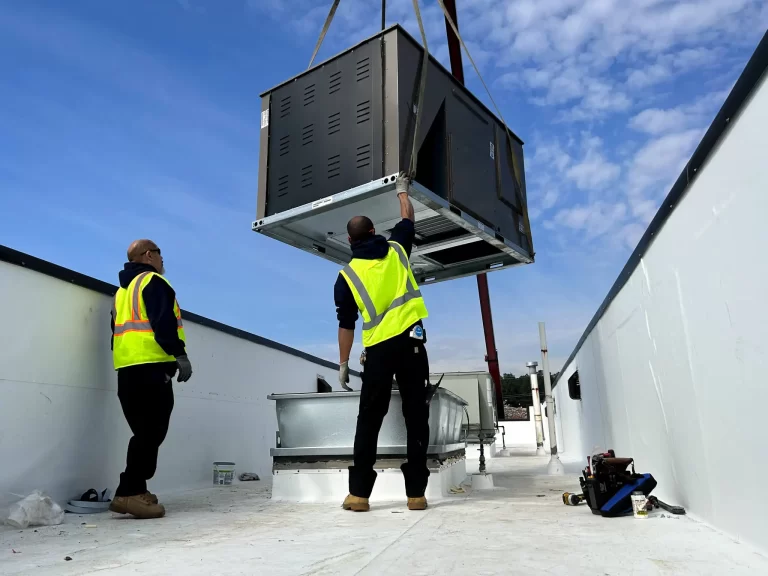Indoor air quality is an important aspect of our overall well-being. The quality of the air we breathe directly impacts our health, comfort, and productivity. In Manassas, where the climate can be extreme at times, it is crucial to understand the importance of maintaining good indoor air quality.
Understanding Indoor Air Quality
Indoor air quality refers to the quality of the air within and around buildings. It is affected by various factors such as pollutants, temperature, humidity, and ventilation. Poor indoor air quality can lead to a range of health issues including respiratory problems, allergies, and fatigue.
When we think about air pollution, we often imagine smog-filled skies and factory smokestacks. However, the air inside our homes and buildings can be just as polluted, if not more so, than the air outside. In fact, according to the Environmental Protection Agency (EPA), indoor air can be two to five times more polluted than outdoor air.
The Importance of Good Indoor Air Quality
Having good indoor air quality is essential for our overall health and well-being. Breathing in clean air can prevent respiratory issues and allergies, improve sleep quality, and boost our immune system. It is especially crucial for individuals with pre-existing respiratory conditions or weakened immune systems.
Imagine coming home after a long day of work, looking forward to relaxing in the comfort of your own space. However, if the air quality in your home is poor, you may find yourself feeling fatigued and experiencing symptoms such as coughing, sneezing, or even difficulty breathing. These symptoms can be particularly troublesome for individuals with asthma or allergies.
Common Indoor Air Pollutants
There are many pollutants that can affect indoor air quality. Some common ones include:
- Dust and dust mites
- Pollen
- Mold and mildew
- Volatile organic compounds (VOCs) from cleaning products, paints, and furniture
- Tobacco smoke
Dust and dust mites are microscopic particles that can accumulate in our homes, especially in areas that are not frequently cleaned. These particles can trigger allergies and asthma symptoms, causing discomfort and respiratory issues. Pollen, another common indoor air pollutant, can enter our homes through open windows and doors, causing allergic reactions in susceptible individuals.
Mold and mildew are often found in damp or poorly ventilated areas such as bathrooms and basements. These fungi release spores into the air, which can be inhaled and cause respiratory problems. Volatile organic compounds (VOCs) are chemicals emitted by various household products such as cleaning solutions, paints, and furniture. Prolonged exposure to VOCs can lead to headaches, dizziness, and even long-term health effects.
Tobacco smoke is a major indoor air pollutant that can have detrimental effects on both smokers and non-smokers. Secondhand smoke contains more than 7,000 chemicals, including at least 70 known to cause cancer. Breathing in secondhand smoke can increase the risk of respiratory infections, asthma attacks, and even lung cancer.
These pollutants can be present in our homes without us even realizing it, making it essential to assess and improve indoor air quality regularly. Simple measures such as proper ventilation, regular cleaning, and using air purifiers can help reduce the levels of indoor air pollutants and create a healthier living environment.
Assessing Indoor Air Quality in Manassas
Properly assessing indoor air quality is the first step towards improving it. There are different methods to determine the quality of the air in your home.
When it comes to assessing indoor air quality, there are several factors to consider. These include the presence of pollutants such as dust, mold, pollen, pet dander, and volatile organic compounds (VOCs). These pollutants can have a significant impact on the health and well-being of you and your family.
One of the most effective ways to assess indoor air quality is by hiring a professional air quality testing service. These professionals have the knowledge, experience, and specialized equipment to accurately measure pollutant levels and analyze air samples. By conducting a thorough assessment, they can identify specific issues and recommend the most effective solutions.
Professional Air Quality Testing
Hiring a professional air quality testing service can provide accurate and comprehensive results. Professionals use specialized equipment to measure pollutant levels and analyze air samples. This helps identify specific issues and determine the most effective solutions.
During a professional air quality assessment, the experts will conduct various tests to evaluate the overall air quality in your home. They may use devices such as particle counters to measure the concentration of airborne particles, including dust, pollen, and mold spores. They may also use gas detectors to identify the presence of harmful gases such as carbon monoxide and VOCs.
Additionally, professionals may collect air samples from different areas of your home and send them to a laboratory for further analysis. This can provide valuable insights into the types and levels of pollutants present in your indoor environment.
Based on the results of the assessment, the professionals will provide you with a detailed report that outlines the findings and recommendations for improving indoor air quality. These recommendations may include actions such as improving ventilation, addressing moisture issues, and using air purifiers or filters.
DIY Air Quality Assessment
If you prefer a do-it-yourself approach, there are simple techniques you can use to assess indoor air quality. Checking for visible signs of mold, monitoring humidity levels, and using air quality monitors can provide valuable insights. However, it is important to note that professional testing may be more reliable for a detailed assessment.
When conducting a DIY air quality assessment, start by inspecting your home for any visible signs of mold or water damage. Mold growth can indicate high humidity levels or water leaks, both of which can contribute to poor indoor air quality. Pay close attention to areas such as bathrooms, basements, and kitchens, as these are common areas for mold growth.
Monitoring humidity levels is another important aspect of assessing indoor air quality. High humidity can promote the growth of mold and bacteria, while low humidity can cause dryness and discomfort. Use a hygrometer to measure the humidity levels in different rooms of your home and take steps to maintain a comfortable range (around 40-60%).
Using air quality monitors can also provide valuable information about the indoor environment. These devices measure various parameters such as temperature, humidity, particulate matter, and VOC levels. By monitoring these factors, you can get a better understanding of the air quality in your home and take appropriate actions to improve it.
While DIY methods can offer some insights into indoor air quality, it is important to remember that they may not provide the same level of accuracy and comprehensiveness as professional testing. If you have concerns about the air quality in your home, it is recommended to consult with a professional air quality testing service for a more detailed assessment.
Techniques to Improve Indoor Air Quality
Once you have assessed the indoor air quality, it’s time to take steps to improve it.
Air Purifiers and Filters
Air purifiers and filters can effectively remove pollutants, allergens, and contaminants from the air. They work by capturing particles and releasing clean air back into the room. It is important to choose a purifier or filter that is suitable for your specific needs and room size.
Natural Air Quality Solutions
In addition to using air purifiers, there are natural solutions that can improve indoor air quality. Increasing ventilation by opening windows, using houseplants to absorb pollutants, and keeping the home clean and dust-free are all effective methods. Additionally, avoiding smoking indoors and using natural cleaning products can further enhance air quality.
Maintaining Healthy Indoor Air Quality
Maintaining healthy indoor air quality is an ongoing process that requires regular cleaning and maintenance.
Regular Cleaning and Maintenance
Regularly cleaning and vacuuming your home helps remove dust, pet dander, and other particles that can affect air quality. Pay attention to areas that accumulate dust, such as carpets, upholstery, and curtains. Additionally, replacing filters in HVAC systems as recommended by manufacturers can significantly improve air quality.
Importance of Ventilation
Proper ventilation is crucial for maintaining good indoor air quality. Opening windows and allowing fresh air to circulate can help reduce the concentration of pollutants. Using exhaust fans in kitchens and bathrooms also helps remove moisture and odors. If necessary, consider installing mechanical ventilation systems to ensure a constant supply of fresh air.
Choosing the Right Air Quality Solution for Your Home
When selecting air quality solutions for your home, there are several key factors to consider.
Factors to Consider
Consider the size of your home, specific air quality concerns, and your budget. Different solutions are designed to address different issues, so it’s essential to choose one that meets your needs. Research different products, read reviews, and consult professionals if necessary to make an informed decision.
Consulting with Air Quality Experts
If you are unsure about which air quality solutions are best for your home, it is recommended to consult with air quality experts. They can assess your specific situation, provide personalized recommendations, and guide you through the process of improving indoor air quality.
By understanding the importance of good indoor air quality and taking the necessary steps to assess and improve it, you can create a healthier and more comfortable living environment in Manassas.


